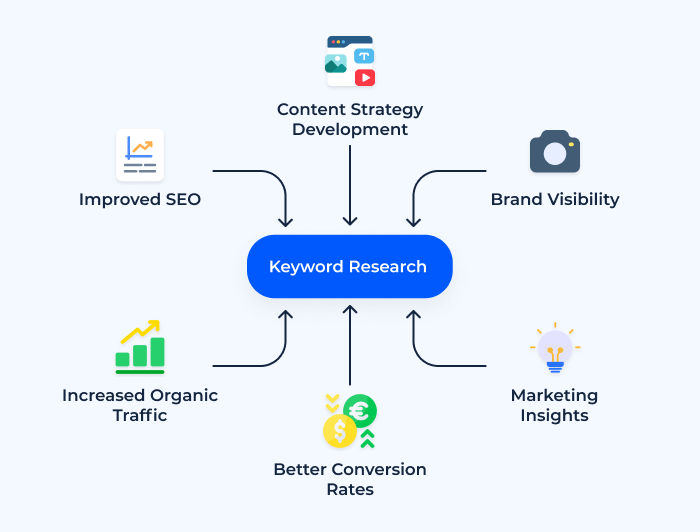This guide outlines the progression of keyword research from basic to expert, factoring in keyword difficulty, search intent, and SEMrush Difficulty Score to help you make informed SEO decisions.
✅ 1. Basic Level – Foundational Research
Keyword Difficulty: Low
SEMrush Difficulty Score: 0–29%
Focus: Identify beginner-friendly keywords that are easy to rank for.
Activities:
Brainstorm seed keywords
Use Google autocomplete and related searches
Explore beginner tools (Ubersuggest, Keyword Planner)
Examples:
“what is digital marketing”
“SEO for beginners”
Goal: Build your first keyword list and generate organic traffic with minimal competition.
✅ 2. Intermediate Level – Competitor & Intent-Based Research
Keyword Difficulty: Low to Medium
SEMrush Difficulty Score: 30–49%
Focus: Expand your keyword list with intent-focused, competitor-backed terms.
Activities:
Analyze competitors using SEMrush or Ahrefs
Categorize keywords by user intent (informational, commercial, transactional)
Identify long-tail keywords with decent traffic and lower competition
Examples:
“affordable SEO services for startups”
“how to increase domain authority”
Goal: Attract targeted traffic by focusing on intent and moderate-difficulty terms.
✅ 3. Advanced Level – Keyword Mapping & Content Strategy
Keyword Difficulty: Medium to High
SEMrush Difficulty Score: 50–69%
Focus: Strategically assign keywords to content and optimize site architecture.
Activities:
Perform keyword mapping (assign keywords to specific pages)
Build content clusters around pillar topics
Optimize on-page SEO (titles, H1s, meta descriptions, internal linking)
Examples:
“best content marketing tools for agencies”
“technical SEO checklist for large websites”
Goal: Improve topical authority and start ranking for more competitive, high-value terms.
✅ 4. Expert Level – Predictive & Conversion-Focused Research
Keyword Difficulty: Varies (Low to Very High)
SEMrush Difficulty Score: 70–84% (for most high-competition commercial terms)
Focus: Target high-converting keywords and emerging trends with ROI potential.
Activities:
Use tools like Google Trends, SEMrush Traffic Insights
Focus on conversion-oriented keywords (bottom of funnel)
Target featured snippets, zero-click queries, and “People Also Ask”
Analyze keyword difficulty vs. ranking opportunity
Examples:
“best AI writing tools 2025 comparison”
“top-rated project management software for enterprises”
Goal: Secure rankings for profitable, trend-driven keywords before your competitors.
✅ 5. Ongoing Optimization – Performance Scaling & Refinement
Keyword Difficulty: Adaptive (depends on market changes)
SEMrush Difficulty Score: Any range depending on growth stage
Focus: Continuously refine and scale keyword performance.
Activities:
Track rankings with SEMrush Position Tracking
Refresh old content with updated keywords
Expand into new content verticals
Analyze Search Console for performance drops
Examples:
Updating a blog post from 2023 with 2025 keyword trends
Expanding content into international or localized keywords
Goal: Sustain and grow organic visibility by evolving with search intent and market shifts.
In SEMrush, search intent is categorized to help marketers and SEOs understand why users search for a particular keyword. Identifying the intent behind keywords allows you to tailor your content and marketing strategies effectively.
Here are the four main types of search intent in SEMrush:
🔍 Types of Search Intent in SEMrush
1. 🧠 Informational Intent
Definition:
The user is looking for information, answers, or how-to guides. They are not ready to make a purchase but are seeking knowledge.
Common keywords:
“What is…”
“How to…”
“Guide to…”
“Tips for…”
Examples:
How to increase website traffic
What is technical SEO
Ideal content formats:
Blog posts
Tutorials
FAQs
Educational videos
2. 🧭 Navigational Intent
Definition:
The user is searching for a specific website, brand, or page. They already know where they want to go.
Common keywords:
Brand or product names
“[brand] login”
“[company] reviews”
Examples:
SEMrush pricing
LinkedIn login
Nike shoes official site
Ideal content formats:
Branded landing pages
Homepages
Product pages
3. 🛍️ Transactional Intent
Definition:
The user is ready to take action — usually to buy or sign up. These keywords indicate high commercial value.
Common keywords:
“Buy”
“Discount”
“Subscribe”
“Get started”
Examples:
Buy SEO tools online
Subscribe to keyword tracking tool
Ideal content formats:
Product/service landing pages
Checkout pages
Sales pages
Limited-time offer pages
4. 📊 Commercial (Investigational) Intent
Definition:
The user is comparing products or services with the intent to make a decision soon. They’re in the consideration phase.
Common keywords:
“Best”
“Top
”“[Product] vs [Product]”
“Reviews of…”
Examples:
Best keyword research tools for beginners
Ahrefs vs SEMrush comparison
Ideal content formats:
Comparison articles
Product roundups
Testimonials and case studies
Review videos
🔄 SEMrush in Action
In SEMrush, keyword intent is automatically detected and labeled in the Keyword Overview, Keyword Magic Tool, and Position Tracking Tool, helping you:
Create intent-aligned content
Improve targeting in SEO/PPC campaigns
Maximize conversions by matching content to searcher behavior







0 Comments